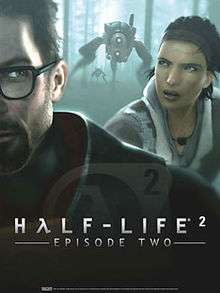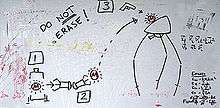Half-Life 2: Episode Two
| Half-Life 2: Episode Two | |
|---|---|
 | |
| Developer(s) | Valve Corporation |
| Publisher(s) | Valve Corporation |
| Composer(s) | Kelly Bailey |
| Series | Half-Life |
| Engine | Source |
| Platform(s) | Microsoft Windows, PlayStation 3, Xbox 360, OS X, Linux |
| Release | |
| Genre(s) | First-person shooter |
| Mode(s) | Single-player |
Half-Life 2: Episode Two (stylized as HλLF-LIFE2: EPISODE TWO) is a first-person shooter video game, the second in a series of episodic sequels to the 2004 Half-Life 2. It was developed by Valve Corporation in tandem with Episode One, the first game in the series, and released in 2007 via Valve's Steam content distribution platform.[1] The episode was released both separately and as a part of a bundled package, The Orange Box.[2]
Episode Two gameplay consists of expansive environments, travel and reduced linear play, continuing Valve's policy of orienting each episode around a particular theme or set of technologies. Following the closing events of Episode One, it sees Gordon Freeman and the series' other major characters moving away from City 17 to the surrounding countryside.[1]
The retail version was released on October 10, 2007, in North America and Russia for Windows and Microsoft's Xbox 360 after repeated delays. The version for the PlayStation 3 was to be released "around two or three weeks later", as it was produced separately at the Electronic Arts UK studio, according to Valve marketing director Doug Lombardi.[3] This version was further delayed. For the rest of the world, the release date was October 18.[4] The Steam version was released worldwide on October 10, 2007.
Gameplay
As with its predecessors, the game is played in the first person as series protagonist Gordon Freeman against transhuman troops, known as the Combine, and other hostile alien creatures. Levels are linear but add a more open environment, consisting of puzzles and first-person shooter game-play. Sequences involving vehicles are interspersed throughout the game, breaking up moments of combat.
One of the focal points of Episode Two was meant to be increased use of vehicles in open areas. However, the game retains its original linear style until the final battle.[5] Episode Two has more puzzles than Episode One, including the biggest physical puzzle yet in the series—a damaged unstable bridge.[5] The game features numerous "achievements" (similar to PlayStation 3's Trophies and Xbox Live's Achievements) for carrying out certain tasks. Some are essential to game progress, such as helping fight off an antlion invasion, or defeating the first Hunters. Others are optional tricks or feats the player can perform, such as killing a Combine soldier with their own grenade or running down a certain number of enemies with the car.[5]
Enemies
Episode Two featured a new Hunter enemy, which had just been seen briefly in a recorded message in Episode One. The Hunter serves as one of the most dangerous enemies within the game and as means of emotional development for Alyx Vance. The Hunter is a powerful and resilient enemy which players must often run from while seeking a means to fight back; Episode Two's environments are designed with this in mind.[6]
An interview in the August 2006 issue of PC Gamer magazine revealed that the Hunter stands 8 feet (2.4 m) tall. Erik Johnson, the game's project lead, states that the Hunters are "big and impressive, but they can go anywhere the player can go", as the player can encounter them both indoors and outdoors.[7] Ted Backman, senior artist for Valve, talks about how the Hunter can express emotions, being a somewhat non-human character. "We want the Hunter to be able to express nervousness or aggression, [to show you] whether it's aggressive, hurt, or mad." Hunters are very aggressive and they tend to operate in packs, but can also be found supporting other Combine troops. Late in the game, they can be found escorting Striders, using their flechette guns to protect the Striders that the player is trying to attack.[7]
Hunters primarily attack the player by bracing themselves and firing bursts from their flechette cannon. Four flechettes can vaporize an ordinary human soldier. If they do not strike a living target, the flechette charge up for several seconds and then explode, dealing minor damage to everything nearby. Hunters may also conduct a charging attack or strike with their legs if the player gets too close. Hunters are vulnerable to all weapons, but to compensate, are still quite resilient, making explosives and the pulse rifle's charged energy ball the most attractive options. Objects thrown with the gravity gun are also effective, especially if the player catches some of their flechettes with the object before hurling it (one of the in-game Achievements). In outdoor environments, they can be run over with a vehicle.[8]
Two new forms of antlion appear in the game. The first is the glow-in-the-dark antlion grub, a harmless, worm-like creature which functions as a minor health pickup and a light source. Killing all 333 of these earns an Achievement. The second is the worker antlion (or 'acidlion') whose body produces a powerful and poisonous acid. In addition to a ranged acid spit attack, they also explode when killed, launching acid around them in a short radius, making them dangerous close-combat opponents. Although they are thematically similar to the bullsquids of the original Half-Life, they are functionally closer to the poison headcrab—as an enemy that the player will instinctively prioritize as a target. A new antlion guardian, which has glow-in-the-dark features, was also added. This "Guardian" hunts and attacks Gordon Freeman as the player endeavors to take the larval extract the Guardian protects. The vortigaunt that accompanies the player forbids him from harming the guardian, fearing the extract will be ruined if he does. The player must therefore accomplish his goal while being harried by a creature he cannot eliminate, though the player is eventually given the chance to kill it.[9]
Weapons

Episode Two features no additions to Gordon Freeman's weapons inventory. Instead, Valve chose to further explore uses for the gravity gun, with which the player can pick up and throw large objects. They introduced more varied Gravity Gun "ammunition", such as logs, flares, and half-height butane tanks, which are easier to aim than full-size fuel drums.[10]
Near the end of the game, the player uses "Magnusson Devices", which designer Dario Casali described as a "sticky bomb that you fire at a Strider's underbelly that will draw power from the Strider's internal power source". The player uses the gravity gun to attach the bombs to tripodal enemy Striders; the bombs detonate when fired upon with any other of the player's weapons, instantly destroying the target. The Hunter escorts prioritize them as targets, either destroying them in the player's grasp or shooting already-attached ones off.[10]
Vehicles
Large sections of the game feature a car which resembles a gutted-and-rebuilt 1969 Dodge Charger. It appears to have been tuned for performance. A radar system is installed later in the game, allowing the player to locate Rebel supply caches. In the final battle, a rear-mounted storage rack for Magnusson Devices is added and the radar is adjusted to track enemies and Magnusson Device dispensers. A homing unit is also installed so the player can quickly locate the car in the chaos of the final battle via a readout in the Hazardous Environment suit.[11]
Plot
The Combine, a multidimensional empire which has enslaved Earth, has used the destruction of their Citadel to open a massive portal. This will allow them to summon reinforcements and destroy the Lambda Resistance. In the mountains outside City 17, Resistance fighters Gordon Freeman and Alyx Vance climb from the wreckage of the train they used to escape the city. At an old transmission station, they establish communication with resistance scientists Dr. Kleiner and Eli Vance at the White Forest base. They learn that the Resistance may be able to close the portal using a copy of a Combine transmission Alyx is carrying. At an abandoned mine, Alyx is critically wounded by a Combine Hunter. A vortigaunt leads them to an underground Resistance shelter. Gordon recovers larval extract from a nearby antlion colony, necessary for the vortigaunts to heal Alyx.[12] While the vortigaunts heal her, the mysterious G-Man contacts Gordon and hints at Alyx's importance to his own plans, revealing that he saved her life at the Black Mesa Research Facility despite objections from an unspecified third party. He instructs the unconscious Alyx to tell her father to "prepare for unforeseen consequences".
After Alyx has recovered, she and Gordon proceed in an old Resistance vehicle, battling Combine troops and surviving an encounter with a Combine Advisor, a high-ranking Combine alien. At White Forest, they are reunited with Dr. Kleiner and Eli, along with Alyx's pet robot D0g. Gordon is also introduced to the egotistical Dr. Arne Magnusson. The scientists are preparing a rocket which they plan to use with the Combine portal code and the satellite array launched by Gordon at Black Mesa to close the Combine portal.[12]
After Gordon fends off a Combine attack on the base, Alyx gives Dr. Kleiner the message from Judith Mossman recovered at the Citadel. It contains footage and the coordinates of the Borealis, an Aperture Science research vessel which, Kleiner explains, vanished along with part of the surrounding drydock. Kleiner insists that it should be used to aid the Resistance effort, while Eli counters that it is impossible to control and must be destroyed. They agree that Alyx and Gordon will travel to the Borealis and attempt to find Mossman. Alyx unconsciously delivers the G-Man's message to her father, shaking him. Alone with Gordon, Eli reveals that it was the G-Man who provided the test sample that caused the Black Mesa incident, and that he whispered the same warning to him as Gordon entered the test chamber. He promises to explain more after the portal is closed.[12]
While the scientists prepare the rocket, White Forest comes under attack by Combine Striders escorted by Hunters. Gordon destroys them using experimental explosive charges created by Magnusson. The scientists launch the rocket and close the portal, trapping Combine forces on Earth. Alyx and Gordon prepare to leave for the Borealis and Eli warns Gordon about the ship's "cargo". The three head to a hangar, intending to board a helicopter, but a pair of advisors burst into the hangar and restrain them. As Eli tries to free them from the advisors' clutches, he is killed by one of the advisors, but as the second advisor prepares to kill Alyx, D0g bursts in through the roof and chases both advisors away. Alyx, sobbing, clutches her father's body.[12]
Development
Episode Two was developed simultaneously with Episode One by a development team led by David Speyrer. This schedule of simultaneous development aided them in streamlining the story between the two games to create an immersive story. The technology used was the same for both games, allowing the development teams to quickly fix any technical problems that might arise from either game; this happened often because of the multi-platform release.[1]
An announcement was made on July 13, 2006 stating that Episode Two would be released on Xbox 360 and PlayStation 3 in addition to the PC, where previous iterations of the series separated.[13] It was originally rumored that Episode Two would be delayed until 2008. On June 14, 2007, however, Valve confirmed the release date for Episode Two to be October 9, 2007 for all announced platforms. Valve handled the development of the game for the PC and Xbox 360, while Electronic Arts British office in Chertsey worked on the PlayStation 3 version of the game.[14] It was announced on September 7, 2007 that the PlayStation 3 version of the game would be delayed because the development studio behind the game was in the United Kingdom, away from Valve's development team, and therefore lagged behind in its schedule. Valve's marketing director, Doug Lombardi, gave assurance that the Xbox 360, PlayStation 3, and PC versions of the game would be identical in functionality and performance.[3]
Audio
Episode Two's soundtrack was composed by Kelly Bailey, who also composed the music for the Half-Life series' other installments. The music is used sparingly throughout, played primarily during scenes of major plot development or particularly important action sequences, such as an early fight with a massive wave of Antlions or speeding down train tracks while being fired on by a helicopter. The soundtrack is included in the Russian edition of The Orange Box and is also sold separately.[15] An audio commentary is also featured, as in Episode One and Lost Coast.[16]
A notable change to the vocal cast is the inclusion of actor Tony Todd as the voice of the Vortigaunts.[17] He replaces Louis Gossett, Jr. in the role.[18] Actor Adam Baldwin voices several of the civilian and rebel NPCs, most notably the character who informs the player of the Striders' locations in the penultimate chapter.[17]
Reception
| Reception | ||||||||||||||||||||||||||
|---|---|---|---|---|---|---|---|---|---|---|---|---|---|---|---|---|---|---|---|---|---|---|---|---|---|---|
| ||||||||||||||||||||||||||
Half-Life 2: Episode 2 received critical acclaim. The game had an average score of 90.68% based on 22 reviews on the review aggregator GameRankings.[19] On Metacritic, the game had an average score of 90 out of 100, based on 21 reviews.[20]
Dan Adams of IGN rated the game 9.4 out of 10 and praised its improved visuals and expansive environments, but cited the short six-hour length as a drawback.[25] He said: "Any way you look at it, Episode Two stands out, even among the Half-Life series, as something special ... a burly experience packed into roughly six hours or so that offers up all the diversity, level design, and thoughtful gameplay we've known while making sure to propel the story forward and leave us wanting more."[25] Bit-tech.net awarded the game a 10 out of 10 score, citing approval of how the story turns and the introduction of side stories and new characters.[10] 1UP.com praised the game, noting that the game's "entire five-hour experience" was "vivid, emotionally engaging, and virtually unsurpassed."[21] PC Gamer UK also applauded Episode Two, noting it "is the most sumptuous chapter of the Half-Life saga, and by a country mile."[26] The New York Times enjoyed the gameplay, saying, "The battles in Episode 2 of Half-Life 2 often require as much ingenuity as they do fast reflexes."[27]
Computer and Video Games commented on the game's graphics, saying that although the game's engine was "starting to look its age," its "wonderful art design and the odd bit of technical spit-shine ensure that Episode Two [...] doesn't lose any of its wow factor." They also noticed that the game "goes about fixing a lot of the niggling complaints we had about Episode One," especially applauding the open forests and rocky hills from Episode Two.[22]
Several reviewers noted shortcomings. The New York Times commented on the story for Episode Two, noting, "While it sows a few seeds for the final episode of the trilogy, the game lacks the driving force of the previous episode."[27] GameSpy criticized the game, saying it is "a little more inconsistent than its predecessors," and that the opening segments of the game were "arguably the weakest" parts.[24]
References
- 1 2 3 Bramwell, Tom (2006-06-06). "Opening the Valve". Eurogamer. Retrieved 2008-05-09.
- ↑ "Half-Life 2: Episode Two". Steam. Valve Corporation. Retrieved 2011-08-02.
- 1 2 Bramwell, Tom (2007-09-07). "Valve explains PS3 Orange Box delay". Eurogamer. Retrieved 2008-05-09.
- ↑ "Half-Life 2: The Orange Box". Play.com. Archived from the original on 2008-03-25. Retrieved 2008-05-09.
- 1 2 3 "Half-Life 2: Episode One Interview 1". GameSpot. 2006-05-30. Archived from the original on 2007-09-29. Retrieved 2008-05-09.
- ↑ Simmons, Alex (2006-08-24). "GC 2006: New Half-Life 2 Trailer Dissected". IGN. Retrieved 2008-05-09.
- 1 2 "Half-Life 2: Episode Two". PC Gamer. August 2006.
- ↑ Goldstein, Hilary (2007-10-09). "The Orange Box Review". IGN. Retrieved 2008-05-09.
- ↑ Caron, Frank (2007-11-16). "Half-Life 2 game statistics live". Ars Technica. Retrieved 2008-05-09.
- 1 2 3 Martin, Joe (2007-10-11). "Half-Life 2: Episode Two". bit-tech.net. Retrieved 2008-05-09.
- ↑ "Steam Update". Steam. 2007-02-16. Retrieved 2008-05-09.
- 1 2 3 4 "Half-Life 2: Episode Two Guide". IGN. Retrieved 2008-05-09.
- ↑ Ocampo, Jason (July 13, 2006). "Half-Life 2: Episode Two - The Return of Team Fortress 2 and Other Surprises". GameSpot. Archived from the original on July 19, 2006. Retrieved March 31, 2016.
- ↑ Remo, Chris (2007-06-15). "Valve confirms Episode Two, Team Fortress 2 launch date". Shacknews. Retrieved 2007-06-15.
- ↑ "The Orange Box Original Soundtrack". Steam. Archived from the original on March 13, 2008. Retrieved 2008-05-09.
- ↑ Cashon, Jonathan (2007-11-05). "'Half Life 2: Episode Two' entertains as strong sequel". University of South Alabama. Archived from the original on 2008-12-27. Retrieved 2008-05-09.
- 1 2 "Half-Life 2: Episode Two". GameFAQs. Retrieved 2008-05-09.
- ↑ "Half-Life 2: The Orange Box". Yahoo! Games. Archived from the original on 2011-07-16. Retrieved 2008-05-09.
- 1 2 "Half-Life 2: Episode Two — PC". GameRankings. Retrieved 2012-04-14.
- 1 2 "Half-Life 2: Episode Two". Metacritic. Retrieved 2012-04-14.
- 1 2 Elliott, Shawn (2007-10-10). "Half-Life 2: Episode 2 (PC)". 1UP.com. Archived from the original on 2007-10-28. Retrieved 2008-08-03.
- 1 2 "Review: Half-Life 2: Episode Two". Computer and Video Games. 2007-10-10. Archived from the original on 2012-06-04. Retrieved 2008-05-09.
- ↑ Reed, Kristan (2007-10-10). "Half-Life 2: Episode Two". Eurogamer. Retrieved 2008-05-09.
- 1 2 Accardo, Sal (2007-10-10). "Half-Life 2: Episode Two (PC)". GameSpy. Retrieved 2008-05-12.
- 1 2 3 Adams, Dan (2007-10-09). "IGN: Half-Life 2: Episode Two Review". IGN. Retrieved 2007-10-10.
- 1 2 "Half-Life 2: Episode Two". PC Gamer UK. 2007-10-10. Retrieved 2008-05-09.
- 1 2 3 Herold, Charles (2007-10-25). "In 1 Box, 3 New Games Filled With Puzzles and Fights". The New York Times. Retrieved 2008-05-12.
External links
| Wikiquote has quotations related to: Half-Life 2: Episode Two (2007) |
